Whenever you enter the Oceanside residence of world maritime historian Peter Knego, you don’t step inside. You step aboard.
Nearly each inch of wall house and almost the entire classic furnishings, doorways, staircase rails and balusters, lighting fixtures, bar, toilet vanities and art work in Knego’s two-story residence had been salvaged over the previous 20 years from the ship-breaking yards of Alang, India, the place outdated ocean liners go to die.
This story is for subscribers
We provide subscribers unique entry to our greatest journalism.
Thanks to your assist.
For almost 50 years, Knego has chronicled in slides, images, information articles and movies the historical past and unlucky destruction of the once-glorious midcentury ocean liners from the late Nineteen Forties to the mid-Nineteen Seventies. In his opinion, no feat of human engineering has ever competed with the ingenuity and majesty of those long-departed luxurious cruise ships just like the Empress of Britain, the Stella Solaris, the Augustus and the Regal Empress.
Not solely does Knego relish sharing his data of those ships, he additionally chronicles their dismantling, and has made it his mission to rescue no matter art work, furnishings and fittings he can from the ships that will in any other case be misplaced.
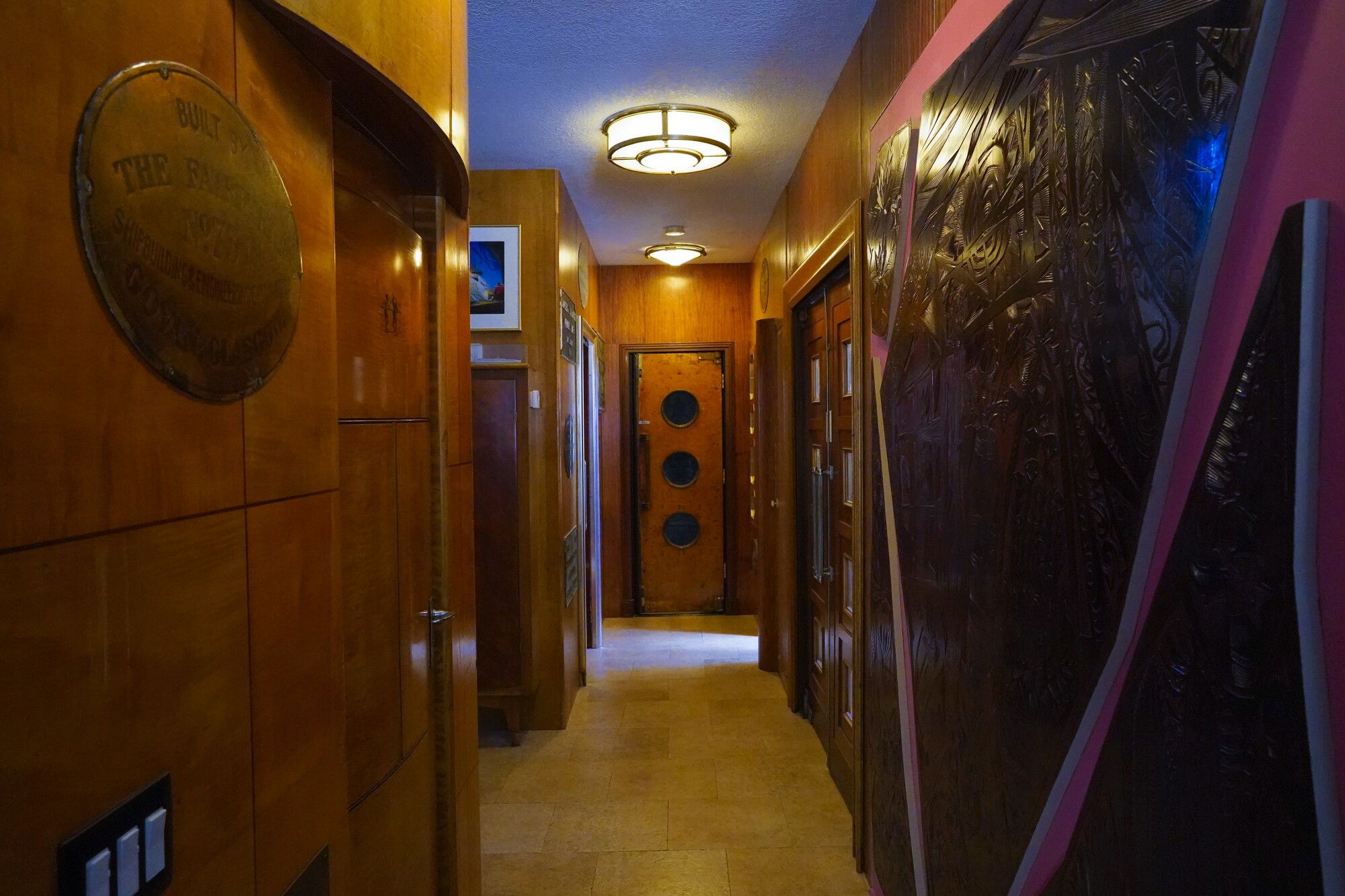
A big carved picket panel in a hallway by Tranquilio Marangoni, comprised of a layer of ebony atop mahogany. The carvings uncovered the mahogany to create the picture of a greenhouse in Buenos Aires, the place the ship sailed from Italy. The three-window door is from the 1956 ship Empress of Britain.
(Nelvin C. Cepeda/The San Diego Union-Tribune)
“It’s devastating to look at them being destroyed,” stated Knego, 61. “It’s like when you love the Empire State Constructing and you need to watch it being demolished. A midcentury ocean liner was the dimensions of the Chrysler constructing, however think about the Chrysler constructing on its facet touring 35 miles an hour at sea. They had been masterpieces of engineering and design.”
Anne Kalosh, senior affiliate editor of the trade publication Seatrade Cruise Evaluate, describes Knego as “one of many foremost ocean-liner historians” on the earth. She additionally stated that no one within the trade is as dedicated to preservation, even at the price of his personal private security, as Knego.
“He feels so dedicated to preserving these relics and the artwork and conserving them alive for future generations, that he’s going there at nice private peril,” Kalosh stated. “Others might buy objects to protect them at auctions and so forth, however I don’t know anybody else who goes to the place the place the ships are being scrapped to avoid wasting objects, as Peter does.”
A born collector
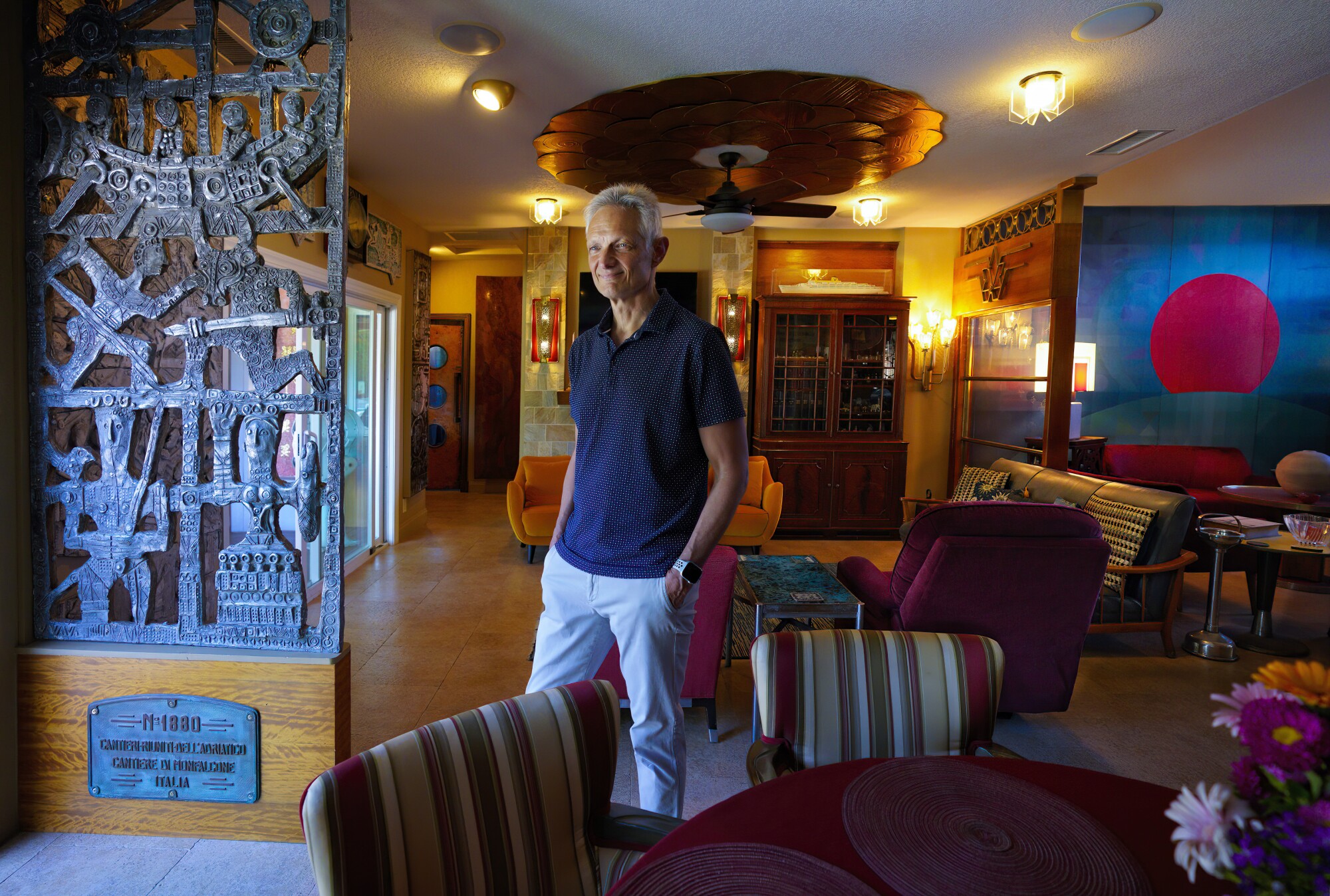
At his residence in Oceanside, Peter Knego stands amongst his intensive assortment of art work, furnishings and decor that when had been a part of numerous cruise ships from all over the world.
(Nelvin C. Cepeda / The San Diego Union-Tribune)
Knego grew up in Hollywood, the son of ‘40s-’50s movie actor Peter Coe and trend mannequin Rosalee Calvert. As a boy, he collected butterflies, cash and stamps and was obsessive about American historical past and bridge-building. When he was in eighth grade in 1973, a trainer assigned him a paper to put in writing on the RMS Lusitania, the British ocean liner sunk by a German submarine in 1915 with almost 2,000 passengers onboard.
Whereas finding out the ill-fated ship, Knego stated he grew to become more and more fascinated with the entire luxurious ships that plied the Atlantic waters, and in 1974 he started visiting and documenting in slides, and later pictures and video, the entire cruise ships that docked in Lengthy Seashore harbor. Within the many years that adopted, he would amass greater than 1 million slides and pictures and greater than 1,000 hours of videotape, which he retains in his workplace at residence and shares on his YouTube channel Peter Knego’s MidshipCinema and his web site midcentury.com.
“I don’t get why extra folks aren’t into ships,” he stated. “I suppose I like issues which can be off the overwhelmed monitor and undersung.”
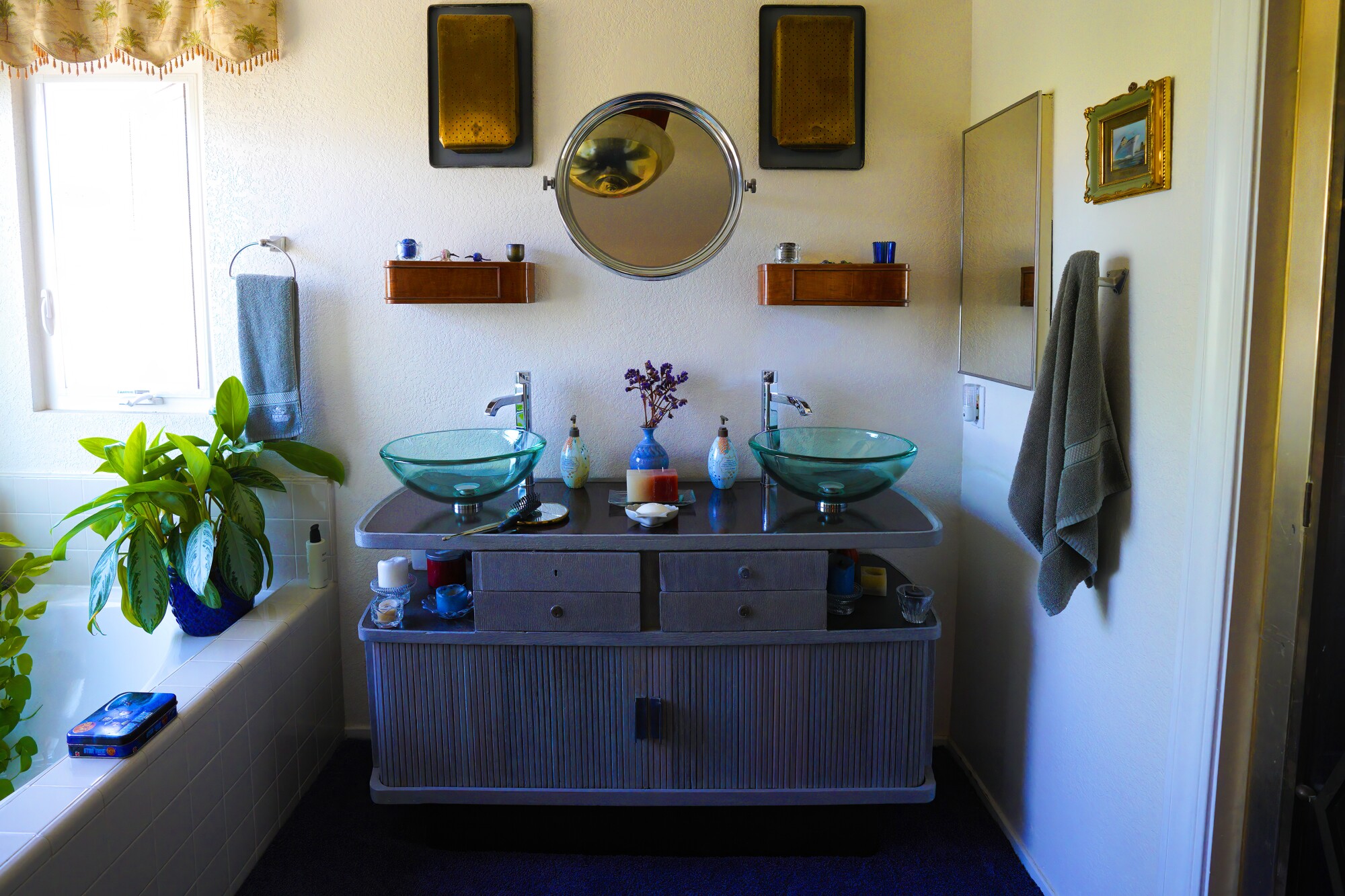
A first-class eating room serving station from the 1952 Italian ocean liner Augustus has been transformed into a rest room vainness within the residence of maritime historian Peter Knego.
(Nelvin C. Cepeda/The San Diego Union-Tribune)
After highschool, Knego studied theater at UC Los Angeles with the concept of changing into a dressing up or scenic designer. As an alternative he fell in love with the music of the Sparks, an influential L.A. digital pop duo, and have become their document promoter — in addition to a promoter for quite a few bands that adopted within the Sparks’ footsteps, just like the Pet Store Boys and Siouxsie and the Banshees — from 1986 to 2006. Knego is amongst these interviewed concerning the band within the 2021 Netflix documentary “The Sparks Brothers.”
Round 1998, Knego stated he grew uninterested in studying newspaper and journal critiques of cruise ships as a result of the writers hardly ever had a grasp of nautical phrases or maritime historical past, so he launched into a brand new profession as a cruise journey author. Through the years he has written extensively for Travel Weekly, USA Today, Porthole, TravelAgeWest, Ships Monthly within the U.Okay. and the now-defunct magazines MaritimeMatters and Cruise Journey.
As a cruise author, Knego stated he prefers writing concerning the smaller ships that journey to extra distant locations than right this moment’s monumental floating cities as a result of he favored the intimacy of the outdated ships and their stunning and distinctive inside craftsmanship.
Preserving historical past
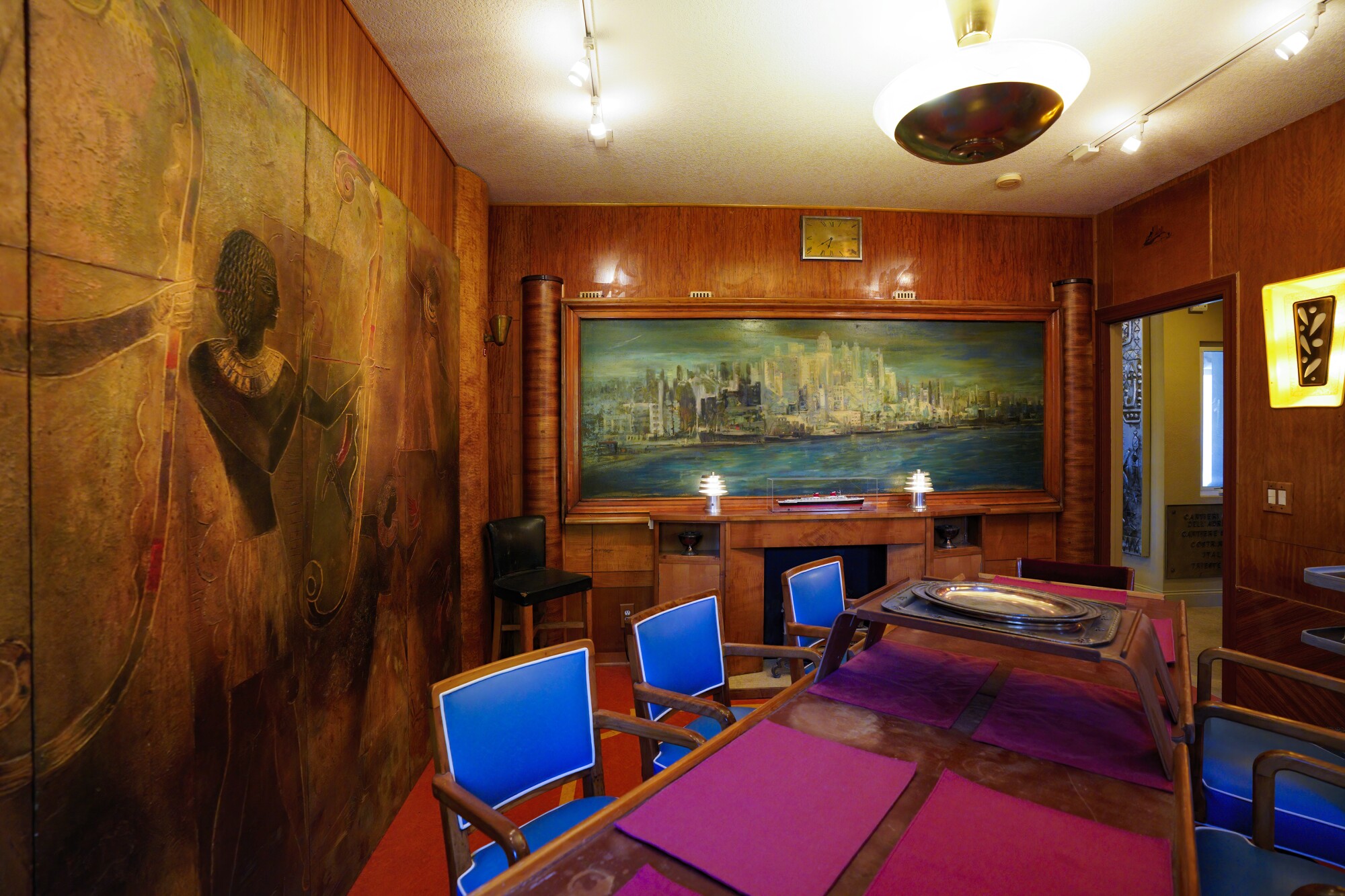
The eating room options linoleum decking to emulate that of a British liner from the Nineteen Fifties. The Searching Scene in Historical Egypt portray is by Giovanni Majoli, an artist from Ravenna. The portray of New York Harbor by William Ware, who exhibited with Modigliani within the Nineteen Forties and was employed by the Windsors to revive a few of the artworks in Windsor Fortress after a serious fireplace. It’s from the SS Olympia, a Greek liner that was constructed within the U.Okay. in 1953.
(Nelvin C. Cepeda / The San Diego Union-Tribune)
Most cruise ships of the twentieth century had been solely constructed to final 20 or 30 years, however throughout arduous financial occasions, Knego stated cruise traces despatched many extra ships to scrapyards to keep away from the price of upkeep and gas. There was an ideal cull of ships throughout the power disaster within the Nineteen Seventies, then once more after the 9/11 assaults and throughout the Nice Recession and the pandemic.
Many of those ships find yourself in Alang, a 10-mile stretch of seaside in Western India generally known as the world’s largest ship graveyard. Staff toil for $2 day in squalid situations amongst oil fumes, asbestos fibers and monsoon situations to interrupt the ships down into metal plates which can be melted and recycled into rebar, tin cans and different supplies.
Knego is amongst a small group of historians who rescue and protect the contents of ships, however the one one who has recorded tons of of hours of footage of the breakdown course of for his YouTube channel and web site.
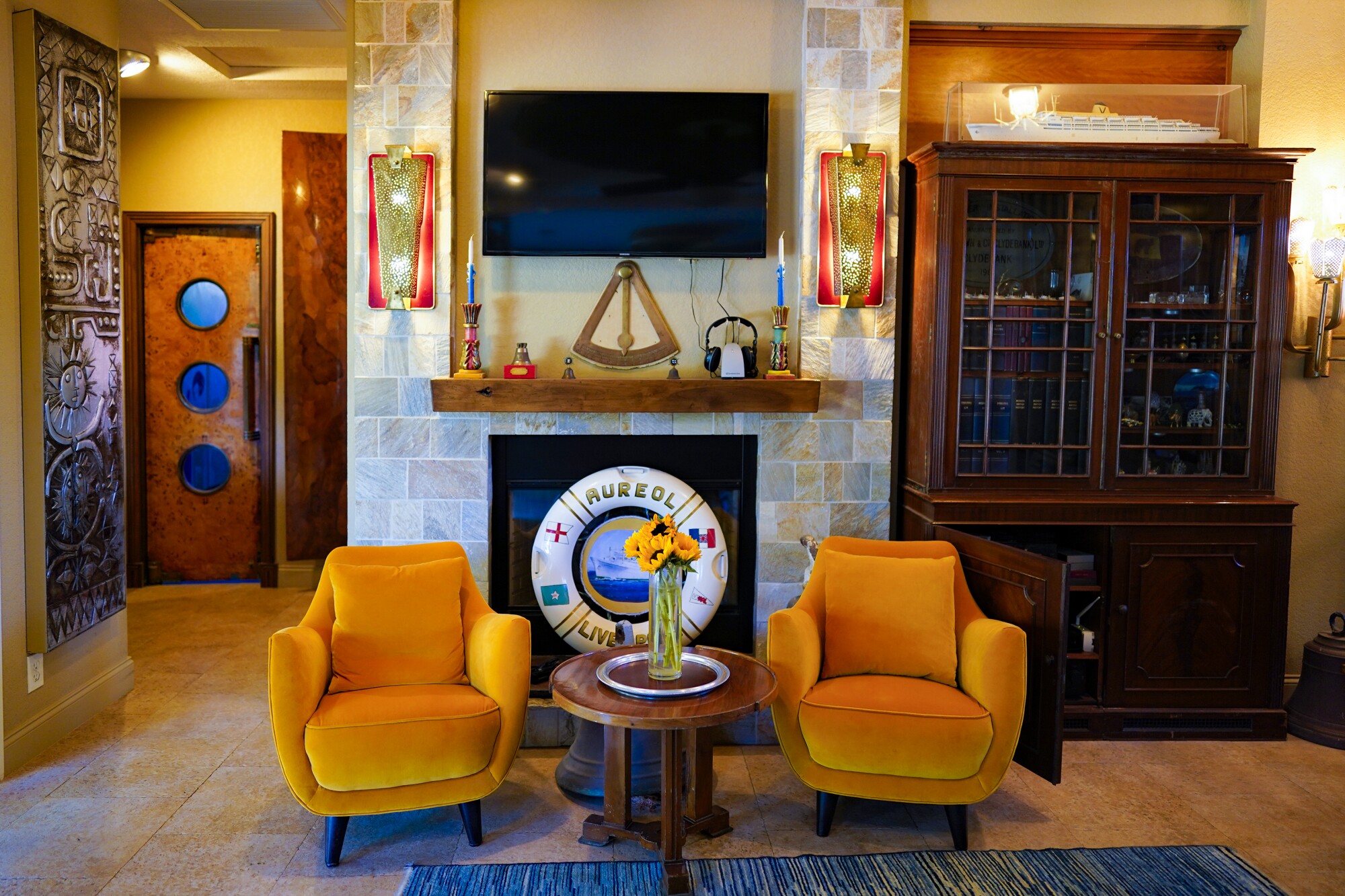
Matching chairs from the 1962 Italian liner Augustus 1952 and, on the wall at left, a hammered metallic art work by Emanuele Luzzati from the Italian deluxe cruise ship Victoria.
(Nelvin C. Cepeda/The San Diego Union-Tribune)
Throughout his 9 journeys to Alang from 2003 to 2014, Knego stuffed a dozen 40-foot containers and one 20-foot container with objects from dying ships. Lots of the contents of those containers have been bought via his web site to different collectors and plenty of have been given away.
In April, Kalosh wrote about how Knego donated several historic items from long-departed Carnival cruise ships for a retro bar that Carnival Cruise Line is putting in on its newest ship to rejoice the corporate’s fiftieth anniversary. Knego has additionally donated a number of chairs from the 1955-era Empress of Britain to the Aurora Restoration Project. Ex-software designer Chris Willson of Stockton purchased a 1953 German ocean-liner on Craigslist a number of years in the past, renamed it the Aurora and is now main an all-volunteer effort to revive the ship to turn out to be a floating lodge.
A few of the objects Knego has bought through the years have gone for 1000’s of {dollars}, however the market is fickle and he hasn’t been capable of import any containers for the reason that pandemic started. A bit over eight years in the past, Knego and his husband, Mike Masino, moved from the Ventura County metropolis of Moorpark to Oceanside as a result of Masino took a job in San Diego. There aren’t as many collectors or inside designers in San Diego County who’re serious about these midcentury items, so as a substitute, a lot of this stuff are in storage, and Knego’s favourite finds have turn out to be everlasting fixtures of their residence.
Dry dock gallery
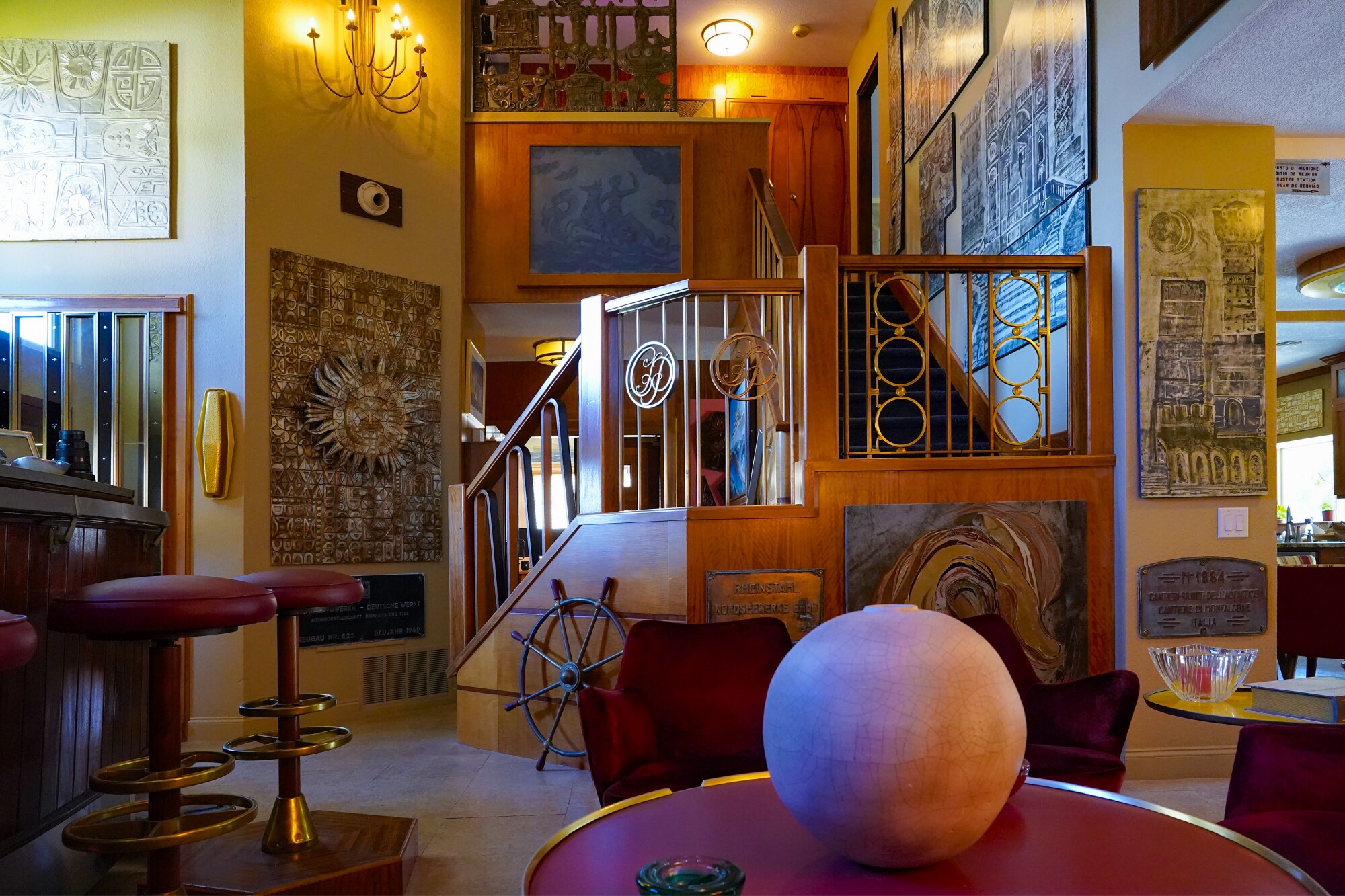
The stair tower railing in Peter Knego’s residence got here from two key ships, the Cunard liner Ivernia of 1955 and the Canadian Pacific liner Empress of Canada of 1961. On the base of the staircase is the massive Solar panel artwork from Italian Victoria 1959. A number of work on the staircase wall are by Emanuele Luzzati, initially from the Italian ocean liner Ausonia, 1958.
(Nelvin C. Cepeda/The San Diego Union-Tribune)
The very first piece Knego salvaged and put in of their house is a walnut tourist-class cocktail bar from the 1951 British liner Aureol. Now totally restored after a tough crossing on a container ship in 2003, it’s the very first thing guests see after they stroll in Knego and Masino’s entrance door, which is a classic picket ship door with curved edges and a drop-down porthole.
Knego’s favourite ocean liners are from the midcentury-era peak within the Nineteen Fifties and ‘60s, significantly these vessels made by Swedish and Italian cruise traces. They employed their nation’s most-famous artisans to fill the ships with distinctive work, sculptures, marquetry, customized furnishings and handicrafts that mirrored their native cultures.
Knego’s favourite ship-craft designer is Italian artist Emanuele Luzzatti, who died in 2007. Through the years, Knego has adorned his home with quite a few Luzzatti melamine work, sculptures and hammered metallic panels salvaged from ships together with the 1957-era Ausonia, the 1959 Victoria and 1965 Stella Oceanis.
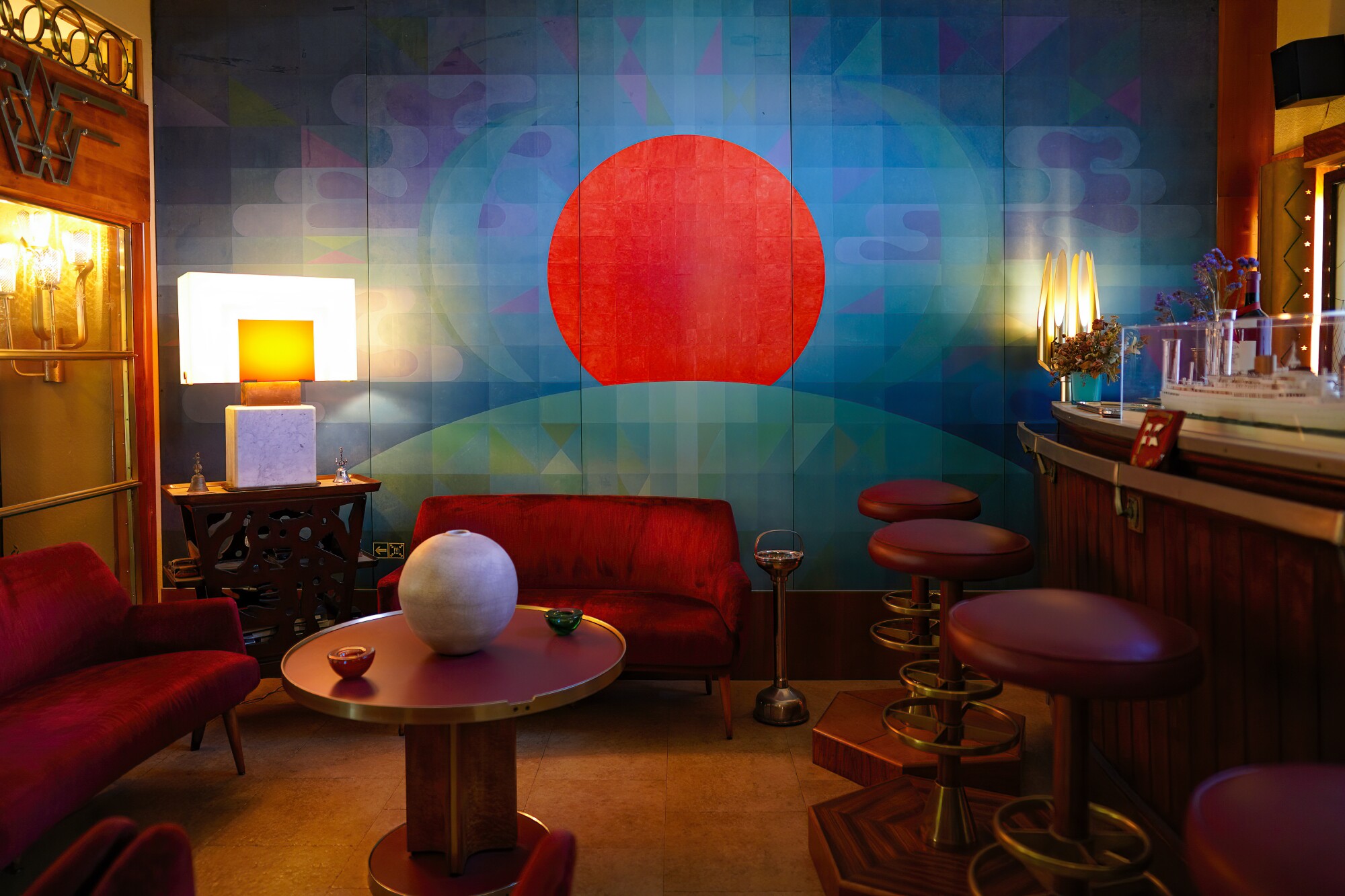
In Peter Knego’s front room, the massive blue artwork panel is named “Fireball In House” and was featured on the SS Hamburg of 1969. It was featured within the film “Juggernaut” and was the backdrop when President Bush Sr. and Gorbachev boarded the ship, which on the time was referred to as Maxim Gorkiy, for the Malta Summit in 1989.
(Nelvin C. Cepeda / The San Diego Union-Tribune)
One of many largest artwork items of their house is “Fireball in House,” salvaged from the 1969 ship SS Hamburg (later acquired by the Soviet Union and renamed the Maxim Gorkiy), which was the place President George Bush Sr. and Soviet chief Mikhail Gorbachev held their floating Malta Summit in 1989.
The furnishings within the TV room and a mermaid statue on the pool deck had been salvaged in 2015 from the Island Princess, certainly one of two ships used as a backdrop for the Nineteen Seventies-era “Love Boat” TV collection. Additionally on the again patio are two pre-Colombian-style Murano glass mosaics by American artist Austin M. Purves, salvaged from the American ship Santa Rosa.
There are hand-carved wooden panels, doorways and art work made out of mahogany, maple, rosewood, makore and zebrano woods, that are particularly uncommon, as new worldwide maritime fireplace codes banned using actual wooden on all ships after 2010.
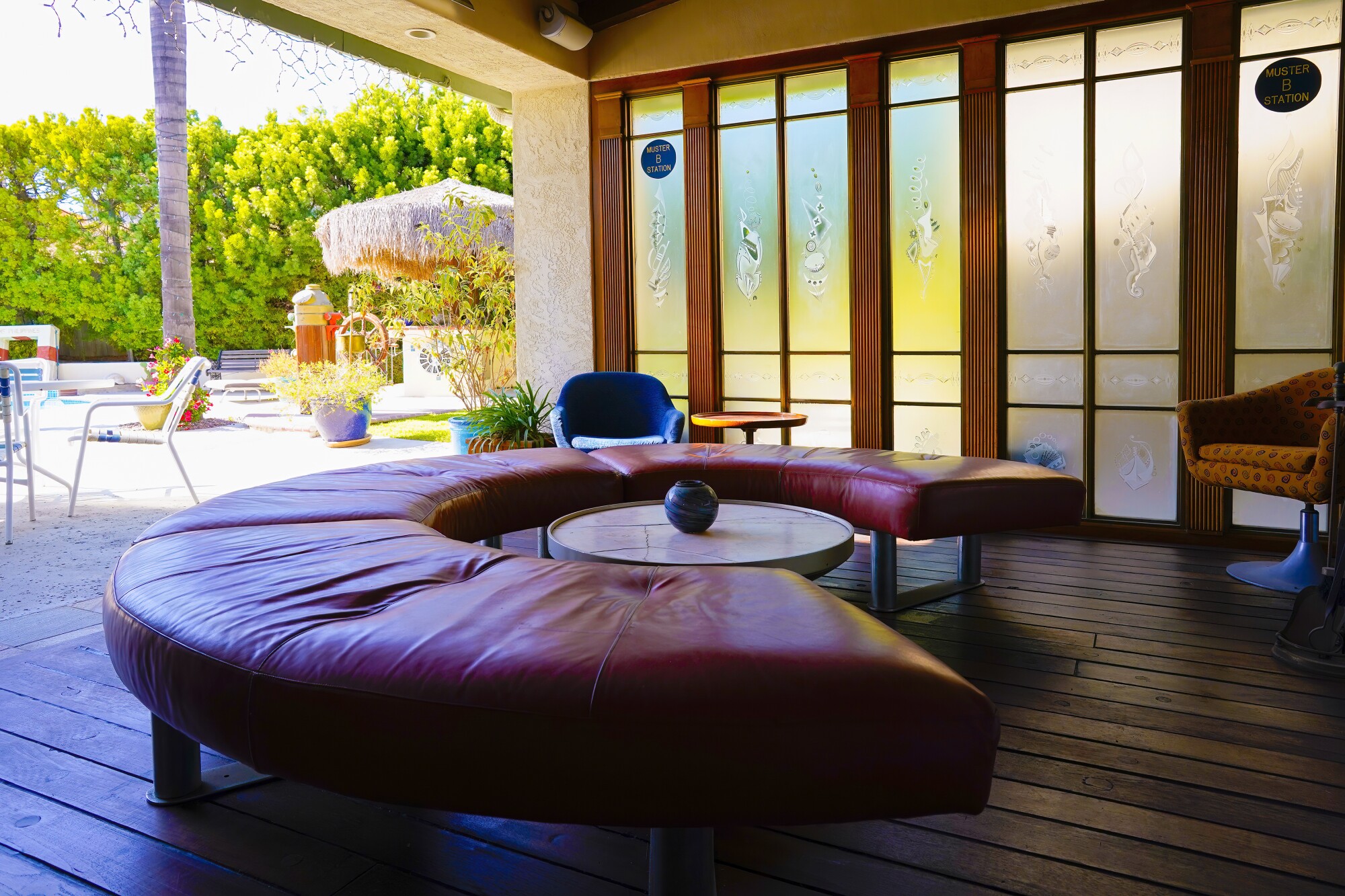
The etched and frosted glass panels on the patio are from the Empress of Britain of 1956 and depict musical devices as they had been from the ship’s ballroom.
(Nelvin C. Cepeda/The San Diego Union-Tribune)
There’s an Egyptian searching scene portray by Italian artist Giovanni Majoli from the 1957 Ausonia. And the staircase railing was created from balusters from the 1955 Ivernia and 1961 Empress of Canada.
Upstairs, there’s a miniature ship museum, with greater than 150 tiny 1:1250-scale fashions of ships that plied the Atlantic Ocean from the late Eighties to the Nineteen Seventies, together with the ship that began all of it for Knego, the Lusitania. He has been amassing the small fashions for many years.
The home can be chockablock with bigger mannequin ships. Essentially the most prized of those is Knego’s mannequin of the New Amsterdam, which is his favourite of all of the ocean liners ever made. It was scrapped in 1974, so he by no means had the prospect to see it in individual.
“The New Amsterdam was in-built 1938. It had two funnels, an exquisite bow and beautiful superstructure and was constructed on the top of the artwork deco interval,” he stated. “If there’s an afterlife, I hope after I get there I can stroll her decks.”
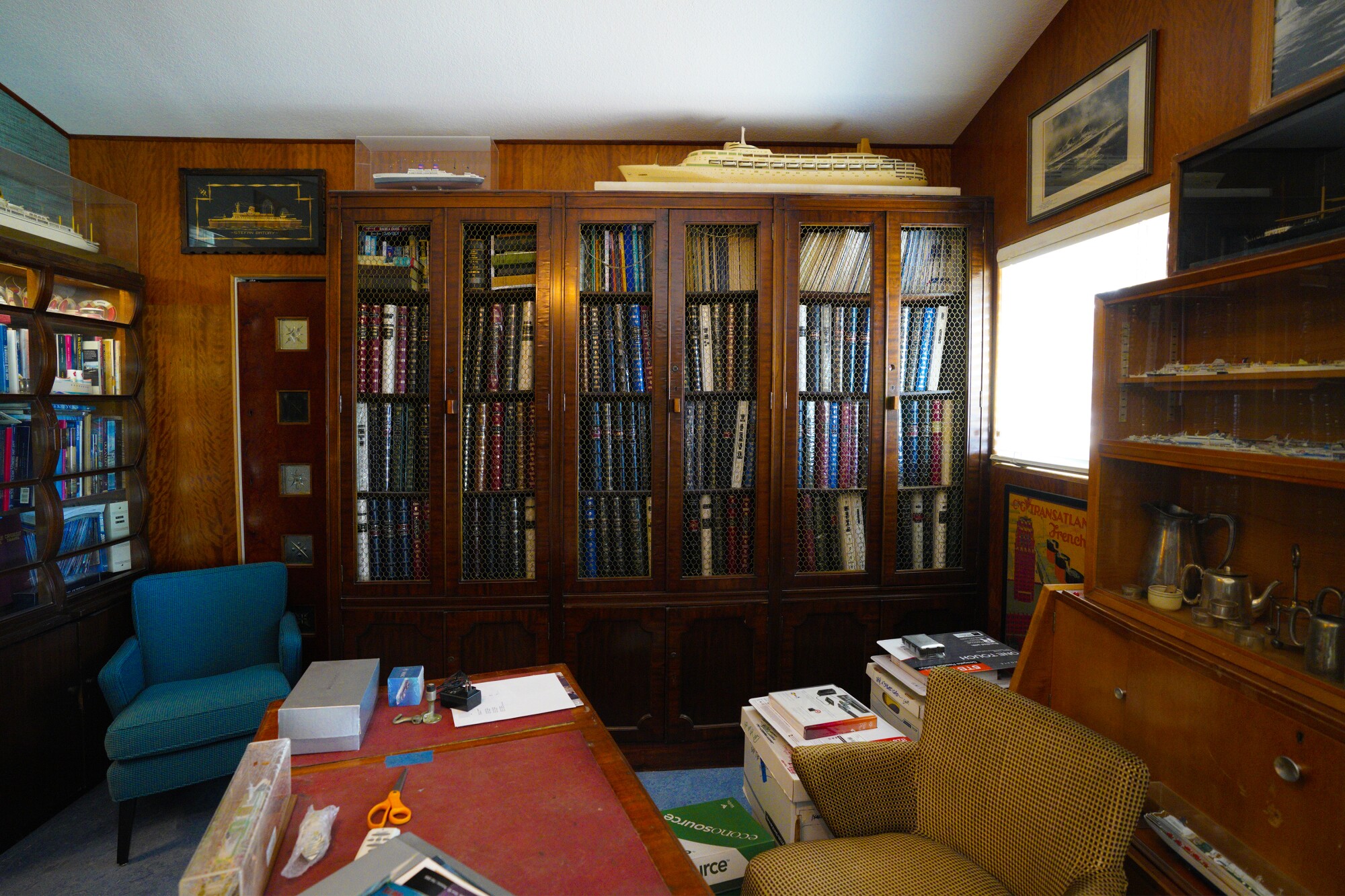
Library cupboards from two British liners, the Cunard liner Ivernia of 1955 and the RMS Transvaal Fortress of 1961, which sailed to South Africa from Southampton.
(Nelvin C. Cepeda/The San Diego Union-Tribune)


